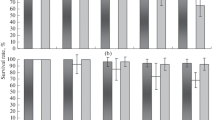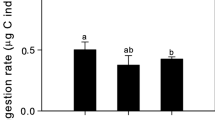Abstract
Egg production and viability in the copepod Temora stylifera (collected in the Bay of Naples, Italy in 1992) were strongly dependent on food type. A flagellate (Isochrysis galbana) diet induced the production of good quality eggs that developed to hatching. By contrast, two diatoms (Chaetoceros curvisetum, Phaeodactylum tricornutum) resulted in poor egg quality, with hatching success as low as 20% of total egg production. With the third diatom tested, Skeletonema costatum, females produced eggs for only 3 to 4 d, after which time they either became sterile or died. These results are discussed in relation to previous findings regarding the impact of the dinoflagellate Prorocentrum minimum and the diatom Thalassiosira rotula on the hatching success of T. stylifera eggs. Low egg viability was possibly not due to an absence of remating or a deficiency of some specific essential nutrient required for egg development but to the presence of inhibitory compounds blocking cell division during early copepod embryogenesis. This questions the traditional view that diatoms are an important food item regulating copepod secondary production.
Similar content being viewed by others
References
Blades-Eckelbarger PI (1986) Aspects of internal anatomy and reproduction in the Copepoda. Proc. 2nd int. Conf. Copepoda. Ottowa, Syllogeus (Nat Mus Can) 58:26–50
Durbin EG, Durbin AG, Smayda TJ, Verity PG (1992) Body size and egg production in the marine copepod Acartia hudsonica during a winter-spring diatom bloom in Narragansett Bay. Limnol Oceanogr 37:342–360
Frost BW (1985) Food limitation of the planktonic marine copepods Calanus pacificus and Pseudocalanus sp. in a temperate fjord. Arch Hydrobiol (Beih Ergeb Limnol) 21:1–13
Gill CW, Harris RP (1987) Behavioural responses of the copepods Calanus helgolandicus and Temora longicornis to dinoflagellate diets. J mar biol Ass UK 67:785–801
Hichcock GL (1982) A comparative study of the size-dependent organic composition of marine diatoms and dinoflagellates. J Plankton Res 4:363–377
Huntley M, Sykes P, Rohan S, Marin V (1986) Chemically-mediated rejection of dinoflagellate prey by the copepods Calanus pacificus and Paracalanus parvus: mechanism, occurrence and significance. Mar Ecol Prog Ser 28:105–120
Ianora A, Poulet SA (1993) Egg viability in the copepod Temora stylifera. Limnol Oceanogr 38:1615–1626
Ianora A, Scotto di Carlo B, Mascellaro P (1989) Reproductive biology of the planktonic copepod Temora stylifera. Mar Biol 101:187–194
Keller MD, Selvin RC, Claus W, Guillard RRL (1987) Media for the culture of oceanic ultraphytoplankton. J Phycol 23:633–638
Kiørboe T, Mohlenberg F, Tiselius P (1988) Propagation of planktonic copepods: production and mortality of eggs. Hydrobiologia 167/168:219–225
Kleppel GS, Holliday DV, Pieper RE (1991) Trophic interactions between copepods and microplankton: a question about the role of diatoms. Limnol Oceanogr 36:172–178
Lampert W (1987) Laboratory studies on zooplankton-cyanobacteria interactions. NZ JI mar Freshwat Res 21:483–490
Mayzaud P, Poulet SA (1978) The importance of the time factor in the response of zooplankton to varying concentrations of naturally occurring particulate matter. Limnol Oceanogr 23:1144–1154
Mayzaud P, Roche-Mayzaud Q, Razouls S (1992) Medium term time acclimation of feeding and digestive enzyme activity in marine copepods: influence of food concentration and copepod species. Mar Ecol Prog Ser 89:197–212
Paffenhöfer G-A (1970) Cultivation of Calanus helgolandicus under controlled conditions. Helgoländer wiss Meeresunters 20:346–359
Paffenhöfer G-A (1988) Feeding rates and behavior of zooplankton. Bull mar Sci 43:430–445
Paffenhöfer G-A, Harris RP (1979) Laboratory culture of marine holozooplankton and its contribution to studies of marine planktonic food webs. Adv mar Biol 16:211–308
Parrish KK, Wilson DK (1978) Fecundity studies on Acartia tonsa (Copepoda: Calanoida) in standardized culture. Mar Biol 46:65–81
Poulet SA (1983) Factors controlling utilization of non-algal diet by particle-grazing copepods. A review. Oceanol Acta 6:221–234
Poulet SA, Ianora A, Miralto A, Meijer L (1994) Do diatoms arrest egg development in copepods? Mar Ecol Prog Ser 111:79–86
Van Rijswijk P, Bakker C, Wink M (1989) Daily fecundity of Temora longicornis (Copepoda, Calanoida) in the Oosterschelde Estuary (SW Netherlands). Neth J Sea Res 23:293–303
Wilson DK, Parrish KK (1971) Remating in a planktonic marine calanoid copepod. Mar Biol 9:202–204
Author information
Authors and Affiliations
Additional information
Communicated by M. Sarà, Genova
Rights and permissions
About this article
Cite this article
Ianora, A., Poulet, S.A. & Miralto, A. A comparative study of the inhibitory effect of diatoms on the reproductive biology of the copepod Temora stylifera . Marine Biology 121, 533–539 (1995). https://doi.org/10.1007/BF00349463
Received:
Accepted:
Issue Date:
DOI: https://doi.org/10.1007/BF00349463




